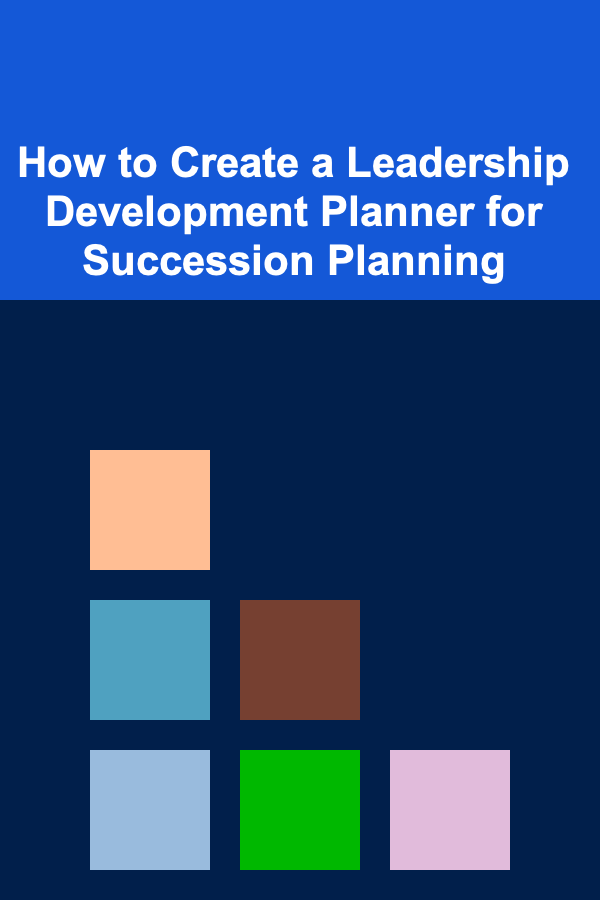
How to Create a Leadership Development Planner for Succession Planning
ebook include PDF & Audio bundle (Micro Guide)
$12.99$7.99
Limited Time Offer! Order within the next:

Succession planning is a critical element of any organization's long-term strategy. It ensures the continuity of leadership by identifying and preparing future leaders. Creating a leadership development planner specifically tailored to succession planning can significantly improve the process of identifying and nurturing high-potential individuals within your organization. A well-designed leadership development planner will not only help the organization prepare for leadership transitions but also boost employee engagement, retention, and overall organizational effectiveness.
In this article, we will dive deep into the creation of a leadership development planner designed specifically for succession planning. We will cover the essential steps and strategies required to create such a planner, including identifying the right candidates, providing targeted development opportunities, and evaluating success. By the end, you'll be well-equipped to design a leadership development program that aligns with your organization's succession planning goals and fosters long-term organizational growth.
Understanding Succession Planning and Leadership Development
Before you begin creating a leadership development planner, it's essential to understand the key concepts involved: succession planning and leadership development.
What is Succession Planning?
Succession planning is the process of identifying and preparing potential future leaders to fill key positions within an organization. This strategic process ensures that leadership transitions are smooth, minimizing the risk of leadership gaps that could impact business operations. Succession planning is not only about replacing individuals in senior positions but also about building a talent pipeline for critical roles across the organization.
What is Leadership Development?
Leadership development, on the other hand, refers to the continuous process of improving and enhancing the leadership capabilities of employees at various levels. Leadership development programs aim to equip individuals with the skills, knowledge, and experience they need to succeed in leadership roles. This includes everything from interpersonal skills and communication to strategic thinking and decision-making.
Interplay Between Succession Planning and Leadership Development
The relationship between succession planning and leadership development is symbiotic. Succession planning helps identify which roles need to be filled and which individuals have the potential to fill those roles, while leadership development provides the training and growth opportunities necessary for those individuals to succeed in leadership positions. In other words, succession planning identifies the "what" and "who," while leadership development addresses the "how."
Step 1: Assess Organizational Needs and Leadership Competencies
Creating a leadership development planner starts with understanding the organization's leadership needs and the competencies required for success. Every organization has its own unique set of challenges, and these should be considered when identifying the necessary leadership qualities.
Conduct a Leadership Needs Assessment
A leadership needs assessment should be the first step in creating your planner. This assessment will help you understand the current and future leadership requirements within your organization.
Questions to consider:
- What are the key leadership roles that are critical to the organization's success?
- What competencies are needed for those roles (e.g., strategic thinking, communication, change management)?
- Are there emerging challenges or opportunities that require new types of leadership (e.g., digital transformation, globalization)?
This assessment will serve as a foundation for your leadership development planner, ensuring that you focus on the right leadership skills for both current and future needs.
Define Core Leadership Competencies
Leadership competencies refer to the specific skills and behaviors that are essential for success in leadership roles. These competencies typically fall into categories such as:
- Personal Effectiveness: Emotional intelligence, adaptability, self-awareness, and resilience.
- Interpersonal Skills: Communication, conflict resolution, team building, and relationship management.
- Strategic Thinking: Vision, critical thinking, problem-solving, and decision-making.
- Operational Excellence: Project management, financial acumen, and process optimization.
- Change Management: Leading through change, innovation, and fostering a culture of continuous improvement.
By defining these competencies, you'll know what to look for in potential leaders and can tailor your leadership development initiatives to target these skills.
Step 2: Identify High-Potential Candidates
The next step in creating a leadership development planner is identifying individuals within your organization who have the potential to assume leadership roles in the future. This is typically done through a talent review process.
Talent Review Process
A talent review is a structured process where senior leaders assess the potential of current employees based on performance and potential. It often includes:
- Performance Evaluation: Reviewing employees' past performance and current capabilities in their current roles.
- Potential Evaluation: Assessing employees' potential for future leadership based on their ability to take on more responsibility, learn new skills, and adapt to new challenges.
- Leadership Characteristics: Evaluating key traits such as initiative, emotional intelligence, and the ability to work collaboratively.
How to Identify High-Potential Employees
High-potential candidates are those individuals who demonstrate strong leadership qualities and the ability to grow into senior roles. Some ways to identify high-potential individuals include:
- 360-Degree Feedback: Collect feedback from colleagues, managers, and subordinates to assess leadership capabilities and areas for growth.
- Performance Metrics: Review employees' achievements, especially those who have exceeded expectations in their current roles.
- Leadership Assessments: Use psychometric tests or leadership assessments to identify traits and attributes associated with successful leadership.
Tip: While high performance is important, potential is equally significant. Look for employees who demonstrate growth mindset and learning agility---those who are open to new challenges and have the capacity to take on new responsibilities.
Step 3: Create a Customized Leadership Development Plan
Once you've identified potential future leaders, the next step is to create a customized leadership development plan for each individual. This plan will outline the specific competencies that need to be developed, along with the development activities and resources that will be used.
Individual Development Plans (IDPs)
An Individual Development Plan (IDP) is a personalized roadmap for each high-potential employee. It should include:
- Clear Leadership Goals: Specific leadership competencies the individual needs to develop.
- Development Activities: Targeted programs or experiences that will help the individual grow in the necessary areas (e.g., leadership training, mentorship, job rotation, or special projects).
- Timeline: A realistic timeline for achieving these goals.
- Feedback Mechanisms: Regular check-ins and assessments to track progress.
Development Opportunities to Consider
- Formal Training Programs: Provide access to leadership development courses, both internal and external. These can cover a range of topics, including communication, conflict resolution, strategic planning, and emotional intelligence.
- Mentorship and Coaching: Pair potential leaders with senior executives or external coaches to provide guidance, advice, and feedback.
- Job Rotation: Allow individuals to experience different roles within the organization to develop a broader perspective and a diverse skill set.
- Stretch Assignments: Give high-potential employees opportunities to take on high-visibility or challenging projects that will help them develop leadership experience.
- Shadowing: Allow potential leaders to shadow senior executives in meetings or during decision-making processes to gain insights into leadership at the highest levels.
Step 4: Implement the Leadership Development Plan
Once the leadership development plan is established, the next step is to implement it. This involves ensuring that the high-potential employees have access to the necessary resources and experiences to develop their leadership skills.
Creating a Supportive Environment
For leadership development to be effective, the organizational culture must support growth and development. Consider the following:
- Provide Access to Senior Leaders: Encourage open lines of communication between potential leaders and senior executives. This helps mentees learn from their experiences and gain insights into leadership.
- Foster a Growth Mindset: Create a culture that values continuous learning, development, and feedback. Encourage individuals to take risks and learn from failures.
Tracking Progress
Regular check-ins and progress reviews are essential for tracking the effectiveness of the development plan. Use performance metrics, feedback from mentors and managers, and self-assessments to measure growth. This allows you to make adjustments as needed and ensure the development plan remains aligned with the needs of the individual and the organization.
Step 5: Evaluate and Refine the Leadership Development Planner
An effective leadership development planner is not a one-time initiative---it's an ongoing process. After the development plans have been implemented, it's important to continuously evaluate their success and make adjustments based on changing organizational needs.
Collect Feedback
Solicit feedback from both the individuals in the program and their supervisors to assess how well the leadership development program is meeting its objectives. Use this feedback to refine the development plans for future leaders.
Measure Organizational Impact
Track the success of your leadership development planner by monitoring key organizational metrics, such as employee engagement, retention, productivity, and the effectiveness of leadership transitions. This will help you determine if the planner is helping the organization build the next generation of leaders.
Continuously Improve
As your organization evolves, so will its leadership needs. Regularly assess your succession planning and leadership development strategies to ensure that they align with the organization's changing goals, challenges, and growth opportunities.
Conclusion
Creating a leadership development planner for succession planning is essential for building a pipeline of capable leaders who can guide your organization through challenges and capitalize on opportunities. By identifying high-potential candidates, providing targeted development opportunities, and evaluating progress, you ensure that your organization is prepared for leadership transitions and has a strong foundation for future growth.
Effective succession planning and leadership development require strategic foresight, dedication, and ongoing commitment to building talent. With the right approach, your leadership development planner can become a vital tool in securing the long-term success of your organization, ensuring that leadership transitions are smooth and that the next generation of leaders is ready to take the helm when needed.
Reading More From Our Other Websites
- [Toy Making Tip 101] DIY Keepsake Toys: Turning Special Occasions into Timeless Treasures
- [Home Space Saving 101] How to Design Space Saving Utility Room Ideas for Functionality
- [Organization Tip 101] How to Prepare Your Closet for Winter Layers
- [Organization Tip 101] How to Keep Craft Projects Organized with Folders
- [Biking 101] How to Choose the Right Bike Sunglasses for Your Ride
- [Home Soundproofing 101] How to Soundproof a Bathroom for Less Echo and Noise
- [Home Lighting 101] How to Use Globe Lights to Add a Touch of Elegance to Any Room
- [Home Space Saving 101] How to Save Space with Smart Home Technology and Gadgets
- [Soap Making Tip 101] Best Luxury Spa‑Quality Soap Formations Using Rare Essential Oils
- [Needle Felting Tip 101] DIY Needle-Felted Wall Art: Step-by-Step Guides for Beginners

How to Avoid Scams and Protect Your Finances Online
Read More
How to Maintain Your Home's Windows and Doors
Read More
How to Perform Simple DIY Home Repairs to Save Money
Read More
How to Transform Unused Spaces into Functional Areas
Read More
How to Use Furniture with Hidden Storage for Toys
Read More
How to Plan a Winter Camping Expedition
Read MoreOther Products

How to Avoid Scams and Protect Your Finances Online
Read More
How to Maintain Your Home's Windows and Doors
Read More
How to Perform Simple DIY Home Repairs to Save Money
Read More
How to Transform Unused Spaces into Functional Areas
Read More
How to Use Furniture with Hidden Storage for Toys
Read More